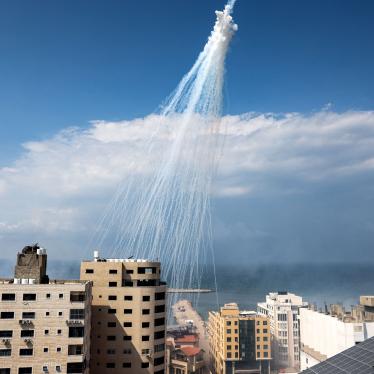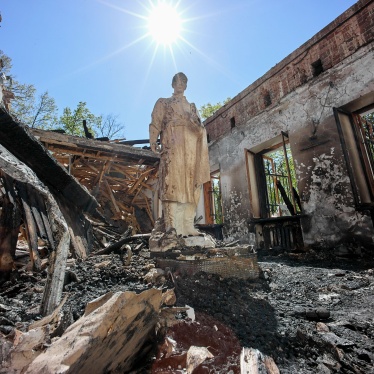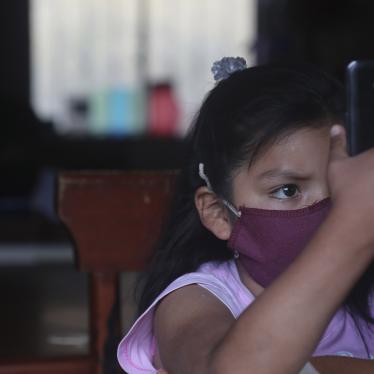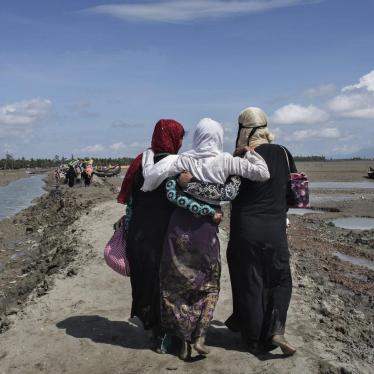(Gaza) – Israel should cease attacks that cause loss of civilian life and property in violation of the laws of war, Human Rights Watch said today. Human Rights Watch investigated seven Israeli airstrikes that were apparent violations of the laws of war before the ground offensive that began on July 17, 2014. The findings and reports of numerous new civilian casualties heightened concerns for the safety of civilians during the ground offensive.
More than 200 Palestinians have been killed since Israel began its ground offensive. The total death toll since the fighting began on July 7 is more than 500, the majority Palestinian civilians, according to reports from United Nations humanitarian agencies.
“After Israeli missiles killed boys on a beach and repeatedly struck a well-marked hospital, one can only be gravely concerned for the safety of civilians caught up in the ground offensive,” said Eric Goldstein, deputy Middle East and North Africa. “Israel needs to do more than try to explain away unlawful attacks – it needs to stop them.”
The attacks Human Rights Watch investigated include a missile attack that killed four boys on a Gaza City pier and wounded three others, multiple strikes over several days on a hospital for paralyzed and elderly patients, an attack on a media worker’s car, and four previously documented strikes. In many, if not all, of these cases, Human Rights Watch found no evidence of a military target. Israeli forces’ failure to direct attacks at a military target violates the laws of war. Israeli forces may also have knowingly or recklessly attacked people who were clearly civilians, such as young boys, and civilian structures, including a hospital – laws-of-war violations that are indicative of war crimes.
Palestinian armed groups have continued to fire rockets that are indiscriminate when directed at Israeli population centers, in violation of the laws of war. Ouda Lafi al-Waj, 32, was killed and four of his family members were wounded when a rocket struck their home in an “unrecognized” Bedouin community near the town of Dimona in southern Israel on July 19. A rocket badly wounded two Bedouin girls in another “unrecognized” village on July 17.
On July 16, staff of the United Nations Relief and Works Agency for Palestine Refugees (UNRWA) found 20 rockets stored in an empty school building. UNRWA promptly removed them, notified all parties, and condemned the military use of its facilities by an unidentified Palestinian armed group. Palestinian armed groups should end unlawful attacks on Israeli population centers and avoid deploying forces and munitions in areas that unnecessarily place civilians at risk.
Israeli airstrikes and tank fire hit the Wafa Rehabilitation Hospital on three days from July 11 to July 17, wounding four patients and staff. While Israel gave various warnings before the attacks, the chronically ill, elderly, and paralyzed patients – none of them mobile – could not be moved quickly or without grave risk to their health.
The laws of war place obligations on all parties to ensure that the wounded and sick receive medical care. Hospitals have special legal protections and may be attacked only if being used to commit acts harmful to the enemy. Israeli claims that armed groups were launching rockets 100 meters from the hospital was insufficient justification for repeatedly striking the hospital. The warnings did not remedy the illegality of repeatedly striking a hospital without a lawful military justification. The fact that Israel used accurate missiles, as well as direct tank fire, yet still struck the hospital, suggests intentional or reckless attacks on the hospital, which are war crimes.
On July 16, an Israeli missile struck a shack on a Gaza City pier, killing four young boys from the Bakr family who were playing nearby. Seconds later, another missile struck, wounding a fisherman and three more children on the beach fleeing the scene. The Israeli military said it attacked the shack because it was an “identified Hamas structure” but mistakenly targeted the boys – aged 10 to 13 – as “fleeing fighters.” The Israelis did not say why the structure was a lawful military objective – a “Hamas structure” is not a military target unless used for military purposes. Attacks that are not directed at a specific military target are unlawful. Nor can an attacker lawfully presume that anyone seen fleeing an attack is a combatant, and in cases of doubt must presume the person is a civilian, protected from attack.
Evidence at the scene indicates that the attack was carried out with Spike missiles, which have sensors that allow the operator to see the target even after the missile is fired and divert them mid-course if the target is not clearly military.
On July 9, an Israeli airstrike killed Hamed Shehab, who worked as a driver for Media24, a Palestinian news agency, and wounded 20 people in a busy area near a mosque. Shehab’s car, marked “TV” on the hood in large letters, was struck while he was driving in southern Gaza City to pick up a fellow media worker. Shehab’s colleagues said he had no affiliation to any armed group. The Israeli military has not provided a justification for that attack, as far as Human Rights Watch has been able to determine. Absent an adequate explanation, the attack was apparently an unlawful attack on a civilian that could also have been expected to cause high civilian casualties because it took place in a crowded neighborhood.
The Israeli military’s stated objective for the ground offensive in Gaza is to destroy tunnels, rockets, and other infrastructure used by Palestinian armed groups that Israeli airstrikes could not destroy. The last ground offensive in Gaza, from December 2008 to January 2009, resulted in the deaths of hundreds of Palestinian civilians, many as the result of unlawful air and artillery attacks, and the unlawful destruction of civilian property. Israel prosecuted only four military personnel for offenses during that conflict, and the heaviest sentence handed down was a seven-and-a-half-month prison term for credit card theft, heightening concerns of continuing impunity in the current fighting.
To deter further violations and seek accountability, Palestine and Israel should seek the jurisdiction of the International Criminal Court (ICC), Human Rights Watch said. Allies should suspend transfers of any materiel to the warring parties that has been documented or credibly alleged to have been used in violation of the laws of war, as well as withhold funding or support for such materiel. Third, countries should support the UN Office of the High Commissioner for Human Rights to establish a fact-finding mission to impartially investigate and report promptly and publicly on violations by all sides, and issue recommendations to the parties and the UN.
“If the international community wants to prevent civilian suffering, it should urgently put the parties on notice that war crimes during this Gaza escalation will not get a free pass,” Goldstein said. “The US and other countries should stop pressuring Palestine not to go to the ICC – pressure that is both misguided and, as evidence of serious violations mounts, hostile to the need for justice.”
Attack on Wafa Hospital
Israeli forces struck Wafa Hospital, in the Shejai’ya neighborhood, east of Gaza City, on at least three days from July 11 to July 17, 2014. Israeli forces had also shelled the hospital before beginning its ground offensive in December 2008.
Before dawn on July 11, 2014, a possible “warning” missile, which did not explode, hit the hospital’s fourth floor. It was followed later that day by several missile strikes that caused extensive damage. After an attack at about 4 or 5 p.m. the hospital’s director, Dr. Basman al-Ashi, received a phone call from someone speaking “Hebrew-accented Arabic who asked if anyone had been injured in the attack and if we were going to evacuate,” he said. “But we couldn’t evacuate when there is no other hospital in Gaza equipped for our patients.” The hospital’s 17 chronically ill, elderly, and paralyzed patients are immobile.
Photographs of the weapons that struck the hospital on July 11, taken by a foreign volunteer and shown to Human Rights Watch, indicate that several solid-propellant missiles, approximately 170 millimeters in diameter, penetrated the hospital’s stairwell and damaged rooms on an upper floor. Many of the missiles used by Israeli air and ground forces have advanced guidance systems and can be accurately targeted.
On July 15, another phone call urged staff to evacuate by 8 a.m. the following day. That evening, the third floor of the care center for the elderly next to the main building was hit, staff and foreign volunteers told Human Rights Watch. Based on photographs of recovered munitions Human Rights Watch viewed, the remnants appear to be sabots from tank-fired projectiles. Tank fire is line-of-sight, direct fire, and Israeli tanks have accurate targeting systems. The repeated Israeli attacks using accurate missile and tank fire that hit the hospital indicate that Israeli forces targeted the hospital intentionally and not accidentally, Human Rights Watch said.
On the night of July 17, shortly before the ground invasion, a call to the hospital’s receptionist at 9 p.m. warned staff to evacuate immediately. Five minutes later, a strike on a nearby building blew out windows in the hospital and two munitions hit the hospital’s upper floors, causing a fire that filled rooms with smoke, Dr. al-Ashi said. Numerous other strikes hit the hospital shortly thereafter, he said. He and two foreign volunteers told Human Rights Watch that they evacuated while the neighborhood was under attack. Two patients were temporarily disconnected from the oxygen supply they need to breathe, and two patients and two staff were injured, but the extent of their injuries was not known.
Dr. al-Ashi told Human Rights Watch:
At 9 p.m. our receptionist got a phone call from the Israeli military. The soldier told him, “You care about your families, your patients. You need to leave the hospital now, because we will bomb it.” About five minutes later, two missiles hit the fourth floor. They continued shelling the building, and a fire started and we lost our electricity. Our nurses were unable to stand up, there was panic. Some of our patients were choking because they need oxygen and they lost the supply. The rooms were full of smoke. We evacuated all of our patients and staff, but four of them couldn’t get out.
The remaining patients and staff were able to leave later that night for al-Sahaba Medical Complex in Gaza’s middle area. The two foreign volunteers said they helped carry patients down the stairs and that they drove an ambulance with two patients in it while the group was evacuating. “They were still shelling when we drove away,” one of the volunteers said.
An Israeli military spokesperson reportedly told a journalist, “We’ve seen a lot of launches of rockets that came from exactly near the hospital, 100 meters near.” He said that “Obviously the target was not the hospital.” Given the precision weapons available to the Israeli military, a target 100 meters from the hospital provides no justification to hit the hospital. Extensive care should have been taken to avoid any attacks on the hospital.
Moreover, even if military forces misuse a hospital to store weapons or shelter able-bodied combatants, which Israel has not alleged, the attacking force must issue a warning that sets a “reasonable time limit” and can attack only “after such a warning has remained unheeded,” according to the International Committee of the Red Cross study of customary international humanitarian law. According to a media article, the Israeli military’s “News Desk,” a department in the spokesperson’s office, separately confirmed that there were no weapons inside the hospital.
Hospitals have special protections under the laws of war. While other presumptively civilian structures become military objectives if they are being used for a military purpose, hospitals only lose their protection from attack if they are being used, outside their humanitarian function, to commit acts harmful to the enemy. Attacks intended for military targets near a hospital would still need to be conducted in a manner that were not indiscriminate or did not cause disproportionate harm to the hospital or its patients. Israel has not provided enough information about the target to justify such damage to the hospital. Israeli forces repeatedly warned hospital staff to evacuate since July 11, but issuing warnings did not remedy the illegality of repeatedly striking a hospital without a lawful military justification.
Killing of Al-Bakr Cousins
At about 4 p.m. on July 16, an Israeli airstrike hit a small outbuilding on the pier of Gaza City’s port, killing four boys who had been on the pier nearby, journalists reported witnesses as saying. A second strike, less than a minute later, wounded one man and three boys who were about 50 meters from the building and running from the first strike. The strike killed Ismail al-Bakr, 9, and his three cousins, Ahed, 10, Zakariya, 10, and Mohammad, 11 – who had been near the outbuilding. News reports identified the injured man as a fisherman from the Bakr family.
In a July 16 statement, the Israeli military said, “The target of this strike was Hamas terrorist operatives,” and that civilian casualties were “tragic.” A reporter with the Israeli daily Haaretz tweeted that an Israeli military official said at a briefing that the outbuilding was an “identified Hamas installation” and that the second attack had misidentified the children running away as “fleeing fighters.” An Israeli military spokesperson, Lt. Col. Peter Lerner, told journalists on July 18 that the military was investigating the incident.
A number of foreign journalists witnessed the attack, according to their published accounts. One journalist, who asked not to be identified, told Human Rights Watch that she was in her room at the Deira Hotel, about 200 meters from the site of the attack, “when I heard an explosion”:
I ran down to the restaurant, where there’s a big patio overlooking the beach, and I saw a group of small kids running toward the hotel and shouting and waving their arms. Hotel staff were shouting to the kids to take cover, then the second strike hit. There was smoke, and several wounded kids made it to the patio, and at least three others came inside the hotel. I helped treat one of them who had a chest wound caused by shrapnel. He was about 13 years old. I saw another boy, a bit younger, with a head wound. Other journalists and hotel staff went and found the bodies of the other boys on the beach. A colleague of mine followed the three wounded boys to the hospital and said they survived.
Israel has an obligation not to attack presumptively civilian objects, such as an outbuilding on a pier, unless they can reasonably be determined to be a military objective. An attacker cannot lawfully presume that anyone seen fleeing an attack is a combatant, and in cases of doubt must presume the person is a civilian, protected from attack. Attacks that are not directed at a specific military target are unlawful.
Photographs taken by another journalist of shrapnel found at the scene indicate that Israeli forces fired Spike missiles in the attack. Spike missiles, produced by the Israeli arms company Rafael, can be launched from ships, aircraft, or ground forces. The missile has its own camera that allows the operator to observe the target from the moment of firing and to divert the fired missile if last-second doubts arise about the target. If the missile used in this attack was endowed with these visual capabilities, its operators should have been able to differentiate between fighters and young children, and to hold fire if a clear determination of fighters could not be made.
Attack Killing Media Worker Hamed Shehab, Wounding 20
An Israeli airstrike on the afternoon of July 9 killed Hamed Shehab, 32, a driver who had been working for Media24, a local Palestinian news agency, in his car while he was driving in the Rimal neighborhood in southern Gaza City, said a colleague who witnessed the attack. Shehab had purchased the car, a gray Skoda, several years ago, and had affixed “TV” in large letters to the hood.
Shehab had worked occasionally as a driver and assistant for the agency since it opened in October 2013, said the station manager, Khaled el-Ashkar, 34. “He would call us or we would call him when we needed extra help, especially during escalations [in hostilities], when we’re really busy,” el-Ashkar said:
He’d been doing this for many months now. He came to work with us full-time three days before he was killed. That same day he was working for us from 7 a.m. in the hospital, he hadn’t left the hospital all day. He went home to change his clothes because they’d been working for so many hours. I can’t understand why he was targeted. He wasn’t affiliated with Hamas.
A Media24 cameraman, Hatem Salmi, 28, said he had been working with Shehab constantly for the previous three days, and on numerous previous occasions. “He was a good friend, I know he wasn’t with any resistance” groups, Salmi said. On the afternoon of July 9, the station manager called them at the hospital to tell them to go home. They decided to go home to change their clothes, then go to the office. Salmi told Human Rights Watch:
He dropped me off at home, in Rimal [neighborhood], and was supposed to come and pick me up. Hamid was also bringing mattresses so we could sleep in the office. And he had tomatoes and potatoes, for us to break the [Ramadan] fast there too. An hour-and-a-half passed and I called him, and he said, “I am downstairs.” I was looking through the window, and I said, “I don’t see you!” He said was right around the corner, and I saw his car, so I went downstairs to quickly say goodbye to my mother, and then went outside. I took two steps outside and heard the attack.
I ran back inside for cover but I thought the attack was on a nearby neighborhood, I didn’t realize it was right in front of me. My wife shouted, “It’s outside!” so I ran out to check on Hamed. I saw that the car that had “TV” on it, Hamed’s car, had been hit. I looked in the car and I didn’t see anyone, I kept looking for Hamed, I kept asking people around me, “Have you seen the driver?” After a while somebody came and told me that there seems to be a person in the car. I had thought Hamed had run away. Then I went and looked again, and I saw only half of his body. There was no upper body, and his legs were underneath the car. I can’t sleep, now. Every time I close my eyes I see his legs under the car.
The attack wounded 20 people, including children, Salmi, news media, and local rights groups said. Another journalist working at the Media24 offices, Asmaa El Ghoul, provided Human Rights Watch with a video uploaded to the Internet that she said showed the aftermath of the attack, and that closely matched witness descriptions of the strike.
Salmi told Human Rights Watch:
There were kids who had just left the mosque on the ground, the youngest one was 6 years old. Three of my cousins were seriously injured. The youngest of them is around 12 years old, another is 17, and the other is 18. They were evacuated for [medical treatment] in Egypt.
The Israeli military has not stated why it attacked the vehicle, as far as Human Rights Watch has been able to determine. Attacks that are not directed at a military target are unlawful. A civilian vehicle, particularly one marked “TV,” is presumptively a civilian object immune from attack. Even if the target had been a military objective, and even if Shehab were the only person killed, carrying out the attack outside a mosque when the area was full of civilians, including children, would suggest a disproportionate attack and a failure to take steps to minimize civilian loss.








